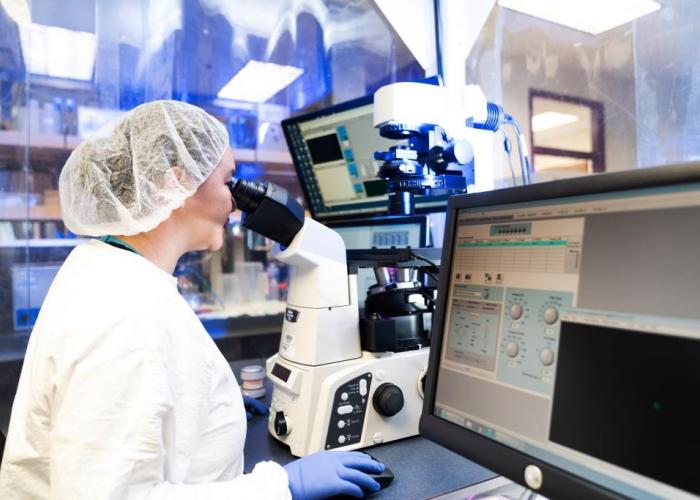
The BC Cancer – Genome Sciences Centre (GSC) celebrates 20 years this month and as researchers look to the future, we’re listing twenty incredible ways the centre has made its mark on the world, not just in the health care industry, which have had lasting impacts locally and globally.
In no particular order:
- GSC researchers contributed significantly to the first working draft of the complete human genome, published in a seminal Nature paper with Dr. Marco Marra, director of the GSC, listed as an author (1999-early 2000s).
- The GSC was the first in the world to sequence the SARS virus during the 2003 global outbreak (2003), accelerating vaccine development.
- The GSC launched the Healthy Aging study aiming to understand genes that promote long-term good health by analyzing super-seniors, people over the age of 85 who have never been diagnosed with cancer, cardiovascular or pulmonary disease, dementia or diabetes (2003).
- The GSC became the only Canadian participant in the Cancer Genome Atlas (TCGA), a landmark project in cancer genomics which to date has characterized tumours from 33 different cancer types (2006).
- The GSC was one of only four genome centres in the world to receive a “Next Generation” DNA sequencing instrument, a technology which revolutionized the modern field of genomics (2006).
- GSC researchers developed ChIP-seq, an innovative technique used to study the epigenome (the chemical mechanisms used by cells to regulate their genomes) which is now used by researchers worldwide (2007).
- The GSC launched the Centre for Clinical Genomics, which became the first laboratory to be certified by the College of American Pathologists to use Next Generation Sequencing technologies for cancer diagnostics, drastically reducing patient waiting times for genetic testing (2009).
- GSC data visualization expert Martin Kryzwinski discovered a novel way to visualize complex genomics data elegantly and efficiently using a method called Circos, which is now used by scientists worldwide (2009).
- GSC distinguished scientist Dr. Marianne Sadar discovered a completely novel drug to treat prostate cancer, and in 2015 the drug entered clinical trials for treatment-resistant patients (1999 - 2010).
- The GSC was the first in the world to publish a paper demonstrating the use of whole genome analysis to inform cancer patient treatment planning, ushering in a new era of personalized cancer treatment (2010). This would later result in the development of the Personalized OncoGenomics program at the GSC.
- GSC researchers published the first evidence of a link between colorectal cancer and Fusobacterium (a type of bacteria), highlighting the link between microbes and cancer (2011). This was later named as one of Time Magazine’s top 10 medical breakthroughs of 2011.
- The GSC joined an international consortium which aims to use genome science to define and understand subgroups of medulloblastoma, the most common childhood brain cancer (2012).
- GSC scientists sequenced and assembled the entire genome of a white spruce tree which, at 20 gigabases, was the largest genome ever sequenced at the time (2013).
- GSC researchers have identified key cancer-causing mutations in several cancer types including non-Hodgkin lymphoma, acute myeloid leukemia, neuroblastoma, and breast cancer among others (various years).
- The GSC developed a world-class “proteomics” facility with the latest technology to study proteins involved in cancer (2014).
- The GSC created novel computational methods for analyzing and assembling the data produced from Next Generation Sequencers, including the 2015 Swiss Institute of Bioinformatics, International Bioinformatics Award-winning ABySS genome assembler.
- Several GSC scientists have been recognized as among the World’s Most Influential Minds, with the GSC director Dr. Marco Marra being acknowledged as the second highest cited researcher in Canada for all disciplines in 2014.
- As part of the International Human Epigenome Consortium, the GSC analyzed over 111 human epigenomes (the chemical mechanisms used by cells to regulate their genomes) (2015).
- In recognition of Canada’s 150th anniversary, the GSC joined other Canadian genome centres aiming to sequence the genomes of 150 iconic Canadian species and to date, has sequenced more than 30 including the beluga whale, grizzly bear, Canada goose, porcupine (2017).
- The GSC developed a new technique to mine novel antimicrobial therapies from the genomes of a variety of species, which is aiding in the global fight against antibiotic resistance (2019).

The list above is only a fragment of the incredible accomplishments made by the researchers, distinguished scientists, and students who work at the GSC. The world-renowned team of researchers at the GSC has significantly advanced our modern understanding of cancer and has helped BC to achieve some of the best cancer outcomes in the world.